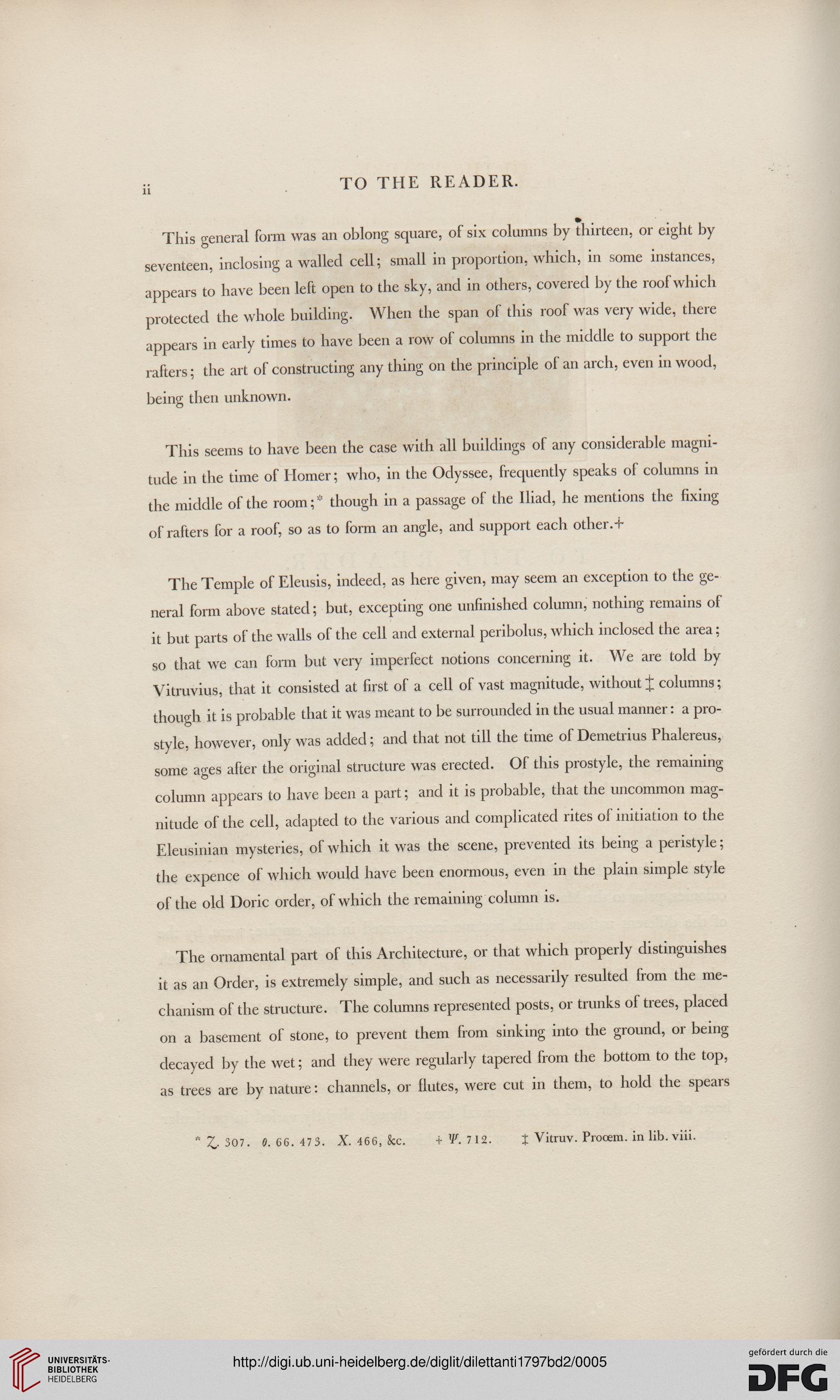11
TO THE READER.
This general form was an oblong square, of six columns by thirteen, or eight by
seventeen, inclosing a walled cell; small in proportion, which, in some instances,
appears to have been left open to the sky, and in others, covered by the roof which
protected the whole building. When the span of this roof was very wide, there
appears in early times to have been a row of columns in the middle to support the
rafters; the art of constructing any thing on the principle of an arch, even in wood,
being then unknown.
This seems to have been the case with all buildings of any considerable magni-
tude in the time of Homer; who, in the Odyssee, frequently speaks of columns in
the middle of the room; * though in a passage of the Iliad, he mentions the fixing
of rafters for a roof, so as to form an angle, and support each other.+
The Temple of Eleusis, indeed, as here given, may seem an exception to the ge-
neral form above stated; but, excepting one unfinished column, nothing remains of
it but parts of the walls of the cell and external peribolus, which inclosed the area:
so that we can form but very imperfect notions concerning it. We are told by
Vitruvius, that it consisted at first of a cell of vast magnitude, without J columns;
though it is probable that it was meant to be surrounded in the usual manner: a pro-
style, however, only was added; and that not till the time of Demetrius Phalereus,
some ages after the original structure was erected. Of this prostyle, the remaining
column appears to have been a part; and it is probable, that the uncommon mag-
nitude of the cell, adapted to the various and complicated rites of initiation to the
Eleusinian mysteries, of which it was the scene, prevented its being a peristyle;
the expence of which would have been enormous, even in the plain simple style
of the old Doric order, of which the remaining column is.
The ornamental part of this Architecture, or that which properly distinguishes
it as an Order, is extremely simple, and such as necessarily resulted from the me-
chanism of the structure. The columns represented posts, or trunks of trees, placed
on a basement of stone, to prevent them from sinking into the ground, or being
decayed by the wet; and they were regularly tapered from the bottom to the top,
as trees are by nature: channels, or flutes, were cut in them, to hold the spears
* Z> 307. 9.66.473. X. 466, &c. t^. 712. % Vitruv. Prooem. in lib. viii.
TO THE READER.
This general form was an oblong square, of six columns by thirteen, or eight by
seventeen, inclosing a walled cell; small in proportion, which, in some instances,
appears to have been left open to the sky, and in others, covered by the roof which
protected the whole building. When the span of this roof was very wide, there
appears in early times to have been a row of columns in the middle to support the
rafters; the art of constructing any thing on the principle of an arch, even in wood,
being then unknown.
This seems to have been the case with all buildings of any considerable magni-
tude in the time of Homer; who, in the Odyssee, frequently speaks of columns in
the middle of the room; * though in a passage of the Iliad, he mentions the fixing
of rafters for a roof, so as to form an angle, and support each other.+
The Temple of Eleusis, indeed, as here given, may seem an exception to the ge-
neral form above stated; but, excepting one unfinished column, nothing remains of
it but parts of the walls of the cell and external peribolus, which inclosed the area:
so that we can form but very imperfect notions concerning it. We are told by
Vitruvius, that it consisted at first of a cell of vast magnitude, without J columns;
though it is probable that it was meant to be surrounded in the usual manner: a pro-
style, however, only was added; and that not till the time of Demetrius Phalereus,
some ages after the original structure was erected. Of this prostyle, the remaining
column appears to have been a part; and it is probable, that the uncommon mag-
nitude of the cell, adapted to the various and complicated rites of initiation to the
Eleusinian mysteries, of which it was the scene, prevented its being a peristyle;
the expence of which would have been enormous, even in the plain simple style
of the old Doric order, of which the remaining column is.
The ornamental part of this Architecture, or that which properly distinguishes
it as an Order, is extremely simple, and such as necessarily resulted from the me-
chanism of the structure. The columns represented posts, or trunks of trees, placed
on a basement of stone, to prevent them from sinking into the ground, or being
decayed by the wet; and they were regularly tapered from the bottom to the top,
as trees are by nature: channels, or flutes, were cut in them, to hold the spears
* Z> 307. 9.66.473. X. 466, &c. t^. 712. % Vitruv. Prooem. in lib. viii.





